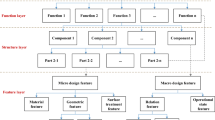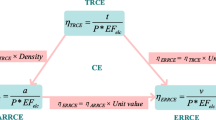Abstract
Key parts refer to the problematic parts which have higher carbon emissions and need to be further optimized in low-carbon design. However, it is difficult to pick them out for designers because the quantitative relationship and unified connection between product life cycle stages and carbon emissions are hard to determine. To efficiently and effectively select the key parts of equipment products, this paper presents a selection methodology based on the characteristic of carbon emissions for low-carbon design. First, a low-carbon design framework is constructed to guide the low-carbon design process. Second, an embodied carbon-energy field (ECEF)-based selection method is proposed to help product designers make a decision. The ECEF denotes the carbon emissions distribution on product structures. Based on the temperature field of products, the ECEF can be constructed by integrating the main life cycle stages of products. The definition of ECEF is given initially. Then, the mapping mechanism and process between the temperature field and ECEF are studied. Meanwhile, the mathematical model of the ECEF is also presented to support the mapping process. Thus, the total carbon emissions distribution of every part and every point can be achieved by the ECEF of products and also seen by product designers visually. Therefore, the key parts could be selected easily. Finally, the proposed method is applied to a CNC gantry type honing machine to validate its feasibility and correctness. The result shows the selection method can be used to identify the problematic parts and points effectively and easily.
Similar content being viewed by others
References
Zhang YF, Ren S, Liu Y, Si SB (2017) A big data analytics architecture for cleaner manufacturing and maintenance processes of complex products. J Clean Prod 142(part 2):626–641. doi:10.1016/j.jclepro.2016.07.123
Bao H (2013) Research on method of carbon footprint analysis and low carbon design mapping for forging machine. Dissertation, Hefei University of Technology
Kroll L, Blau P, Wabner M, Frieß U, Eulitz J, Klärner M (2011) Lightweight components for energy-efficient machine tools. CIRP J Manuf Sci Technol 4(2):148–160
Devanathan S, Ramanujan D, Bernstein WZ, Zhao F, Ramani K (2010) Integration of sustainability into early design through the function impact matrix. J Mech Des 132(8):081004–081004. doi:10.1115/1.4001890
Bakshi BR, Gutowski TG, Sekulic DP (2011) Thermodynamics and the destruction of resources. Cambridge University Press, New York
Gutowski TG, Branham MS, Dahmus JB, Jones AI, Thiriez A, Sekulic DP (2009) Thermodynamic analysis of resources used in manufacturing processes. Environ Sci Technol 43(5):1584–1590. doi:10.1021/es8016655
Song JS, Lee KM (2010) Development of a low-carbon product design system based on embedded GHG emissions. Resour Conserv Recycl 54(9):547–556. doi:10.1016/j.resconrec.2009.10.012
Du YB, Yi Q, Li CB, Liao L (2015) Life cycle oriented low-carbon operation models of machinery manufacturing industry. J Clean Prod 91:145–157. doi:10.1016/j.jclepro.2014.12.028
He B, Tang W, Wang J, Huang S, Deng Z, Wang Y (2015) Low-carbon conceptual design based on product life cycle assessment. Int J Adv Manuf Technol 81(5):863–874. doi:10.1007/s00170-015-7253-5
He B, Tang W, Wang J (2015) Product model integrated with carbon footprint for low-carbon design. Int J Precis Eng Manuf 16(11):2383–2388. doi:10.1007/s12541-015-0307-7
Xu ZZ, Teng ZR, Zhong CQ, Liu ZJ, Ma XF (2014) Multi-objective optimization for performance, cost and carbon tax of low-carbon product. Inf Technol J 13(2):278–285. doi:10.3923/itj.2014.278.285
Wang Q, Tang DB, Yin LL, Salido MA, Giret A, Xu YC (2016) Bi-objective optimization for low-carbon product family design. Robot Cim-Int Manuf 41:53–65. doi:10.1016/j.Rcim.2016.02.001
Ameli M, Mansour S, Ahmadi-Javid A (2016) A sustainable method for optimizing product design with trade-off between life cycle cost and environmental impact. Environ Dev Sustain 1–14. doi:10.1007/s10668-016-9864-x
Kuo TC, Chen HM, Liu CY, Tu JC, Yeh TC (2014) Applying multi-objective planning in low-carbon product design. Int J Precis Eng Manuf 15(2):241–249. doi:10.1007/s12541-014-0331-z
Tao F, Bi LN, Zuo Y, Nee AYC (2016) A hybrid group leader algorithm for green material selection with energy consideration in product design. CIRP Ann Manuf Technol 65(1):9–12. doi:10.1016/j.Cirp.2016.04.086
Chiang TA, Che ZH (2015) A decision-making methodology for low-carbon electronic product design. Decis Support Syst 71:1–13. doi:10.1016/j.dss.2015.01.004
Chu CH, Luh YP, Li TC, Chen H (2009) Economical green product design based on simplified computer-aided product structure variation. Comput Ind 60(7):485–500. doi:10.1016/j.compind.2009.02.003
Su JCP, Chu CH, Wang YT (2012) A decision support system to estimate the carbon emission and cost of product designs. Int J Precis Eng Manuf 13(7):1037–1045. doi:10.1007/s12541-012-0135-y
Zhang XF, Zhang SY, Hu ZY, Yu G, Pei CH, Sa RN (2012) Identification of connection units with high GHG emissions for low-carbon product structure design. J Clean Prod 27:118–125. doi:10.1016/j.jclepro.2012.01.011
Rao RV, Davim JP (2008) A decision-making framework model for material selection using a combined multiple attribute decision-making method. Int J Adv Manuf Technol 35(7):751–760. doi:10.1007/s00170-006-0752-7
Jahan A, Mustapha F, Sapuan SM, Ismail MY, Bahraminasab M (2012) A framework for weighting of criteria in ranking stage of material selection process. Int J Adv Manuf Technol 58(1):411–420. doi:10.1007/s00170-011-3366-7
Deng C, Wu J, Shao X (2016) Research on eco-balance with LCA and LCC for mechanical product design. Int J Adv Manuf Technol 87(5):1217–1228. doi:10.1007/s00170-013-4887-z
Yan JH, Feng CH, Li L (2014) Sustainability assessment of machining process based on extension theory and entropy weight approach. Int J Adv Manuf Technol 71(5):1419–1431. doi:10.1007/s00170-013-5532-6
Li H, Cao H, Pan X (2012) A carbon emission analysis model for electronics manufacturing process based on value-stream mapping and sensitivity analysis. Int J Comput Integr Manuf 25(12):1102–1110. doi:10.1080/0951192X.2012.684715
Dai ZH, Scott MJ (2007) Product platform design through sensitivity analysis and cluster analysis. J Intell Manuf 18(1):97–113. doi:10.1007/s10845-007-0011-2
Sivakumar K, Balamurugan C, Ramabalan S (2010) Evolutionary sensitivity-based conceptual design and tolerance allocation for mechanical assemblies. Int J Adv Manuf Technol 48(1):307–324. doi:10.1007/s00170-009-2256-8
He B, Tang W, Huang S, Hou SC, Cai HX (2015) Towards low-carbon product architecture using structural optimization for lightweight. Int J Adv Manuf Technol:1–11. doi:10.1007/s00170-015-7676-z
Neugebauer R, Drossel WG, Ihlenfeldt S, Harzbecker C (2009) Design method for machine tools with bionic inspired kinematics. CIRP Ann Manuf Technol 58(1):371–374. doi:10.1016/j.cirp.2009.03.089
Martinez M, Xue DY (2016) Development of adaptable products based on modular design and optimization methods. Procedia CIRP 50:70–75. doi:10.1016/j.procir.2016.04.078
Zhao L, Ma JF, Wang T, Xing DH (2010) Lightweight design of mechanical structures based on structural bionic methodology. J Bionic Eng 7:S224–S231. doi:10.1016/S1672-6529(09)60239-0
Li BT, Hong J, Liu ZF (2017) A novel topology optimization method of welded box-beam structures motivated by low-carbon manufacturing concerns. J Clean Prod 142(part 4):2792–2803. doi:10.1016/j.jclepro.2016.10.189
Lu Q, Zhou GH, Zhu JK (2016) A calculation method of embodied carbon-energy for low-carbon products. Procedia CIRP 57:680–685. doi:10.1016/j.procir.2016.11.118
Kara S, Li W (2011) Unit process energy consumption models for material removal processes. CIRP Ann Manuf Technol 60(1):37–40. doi:10.1016/j.cirp.2011.03.018
Lu Q, Zhou GH, Zhou C, Xiao ZD (2016) A carbon emissions allocation method based on temperature field for products in the usage stage. Int J Adv Manuf Technol:1–13. doi:10.1007/s00170-016-9799-2
Author information
Authors and Affiliations
Corresponding author
Rights and permissions
About this article
Cite this article
Lu, Q., Zhou, GH., Xiao, ZD. et al. A selection methodology of key parts based on the characteristic of carbon emissions for low-carbon design. Int J Adv Manuf Technol 94, 3359–3373 (2018). https://doi.org/10.1007/s00170-017-0522-8
Received:
Accepted:
Published:
Issue Date:
DOI: https://doi.org/10.1007/s00170-017-0522-8




